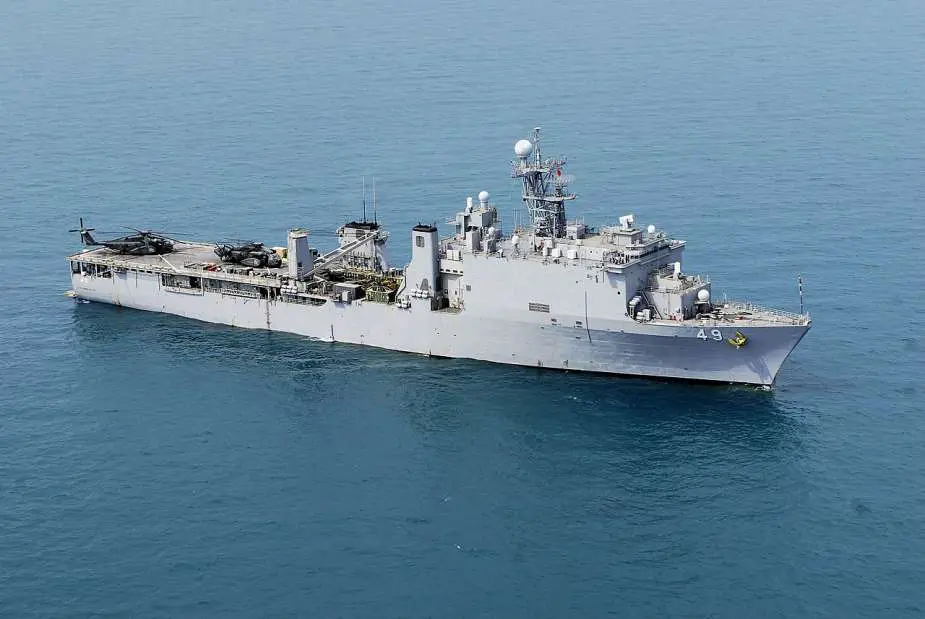Breaking news
US Navy deploys V-BAT vertical take-off drone from USS Harpers Ferry in Pacific Fleet exercise.
On March 27, 2024, members from the US 15th Marine Expeditionary Unit deployed a V-BAT unmanned aerial system (UAS) from the flight deck of the USS Harpers Ferry (LSD-49), a dock landing ship. This event took place in the Pacific Ocean as part of routine operations conducted by the Boxer Amphibious Ready Group within the U.S. 3rd fleet's jurisdiction.
Follow Navy Recognition on Google News at this link
 On December 21, 2022, the V-BAT, alongside a Skyways V2.6B UAV, conducted the first unmanned cargo delivery operation to a US Navy ship at sea. (Picture source: US DoD)
On December 21, 2022, the V-BAT, alongside a Skyways V2.6B UAV, conducted the first unmanned cargo delivery operation to a US Navy ship at sea. (Picture source: US DoD)
The V-BAT, with its designation as MQ-35A, is an unmanned aerial vehicle (UAV) characterized by its vertical take-off and landing (VTOL) capabilities. Initially developed by Martin UAV and later by Shield AI, the V-BAT is primarily used by the United States Navy. In April 2021, the V-BAT was selected by the US Navy for further prototyping and development, indicating the Navy’s interest in VTOL UAVs for reconnaissance purposes. By February 2022, the V-BAT attracted international attention, with the Brazilian company VSK Tactical purchasing an undisclosed quantity of the drones for security and monitoring purposes.
On December 21, 2022, the V-BAT, alongside a Skyways V2.6B UAV, conducted the first unmanned cargo delivery operation to a US Navy ship at sea. Each UAV carried a cargo load of 22.5kg over a distance of 200nm (approximately 370km) to a moving ship, demonstrating the potential for logistical applications of UAV technology.
In March 2023, the United States Army announced the selection of the V-BAT to participate in the Future Tactical Unmanned Aircraft System (FTUAS) competition, Increment 2, looking for potential replacements for the RQ-7B Shadow. This participation was in collaboration with Northrop Grumman, showcasing the ongoing evaluation of the V-BAT for various military applications.
On October 9, 2023, Shield AI announced the development of drone-swarming capabilities for the V-BAT, indicating an expansion in its operational functionality.
The V-BAT is designed for both defense and commercial uses, with applications ranging from search and rescue to border security and disaster management. The V-BAT can be assembled in less than 30 minutes and is capable of operation from varied platforms, including light tactical vehicles and helicopters like the UH-60 Black Hawk.
The V-BAT uses a single-engine ducted fan for propulsion, which allows for VTOL operations without the need for additional support equipment. This model supports autonomous operations, utilizing pre-programmed flight paths to enhance operational safety.
Capable of carrying various payloads, the V-BAT can be equipped with electro-optical/mid-wave infrared cameras for imaging, supported by an automatic identification system (AIS) and AI-based capabilities for wide-area searches. The UAV is powered by a Suter TOA 288 two-cylinder engine, allowing it to reach a service ceiling of 20,000 feet and fly for up to 11 hours, demonstrating its ability to operate under a range of environmental conditions.
The USS Harpers Ferry (LSD-49) is the lead ship of the Harpers Ferry-class of dock landing ships in the US Navy, which are designed to support amphibious operations. It is powered by four Colt Industries 16-cylinder diesel engines, achieving a combined output of 33,000 shaft horsepower, with the capability to reach speeds exceeding 20 knots (37 km/h; 23 mph). The vessel measures 610 feet in length, 84 feet in beam, and has a draft of 21 feet.
Equipped to transport and deploy two Landing Craft Air Cushion (LCAC) vehicles, the USS Harpers Ferry enhances the US Navy's capability to land forces on hostile shores. Its armament includes two 25 mm Mk 38 rapid-fire cannons, two 20 mm Phalanx Close-In Weapon System (CIWS) mounts, two Rolling Airframe Missile launchers, and six 0.5 in M2HB machine guns. The ship is also designed to accommodate 22 officers, 397 enlisted personnel, and a marine detachment that can number up to 504 individuals (402 standard plus a 102-person surge capacity), underlining its role in supporting large-scale amphibious operations.

The USS Harpers Ferry (LSD-49) can accommodate a marine detachment of up to 504 individuals. (Picture source: US Navy)


























